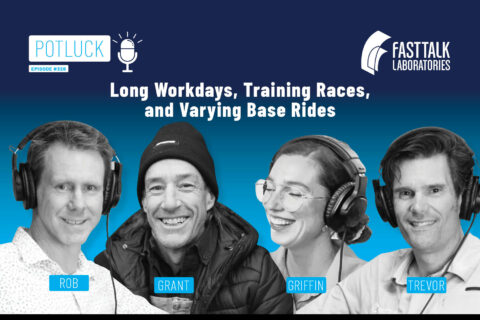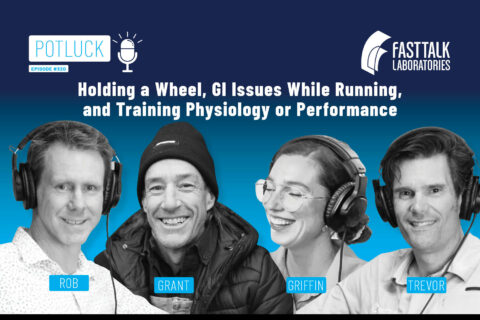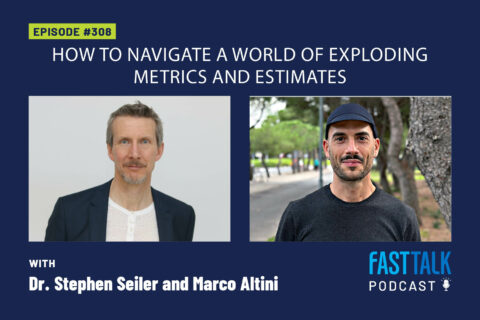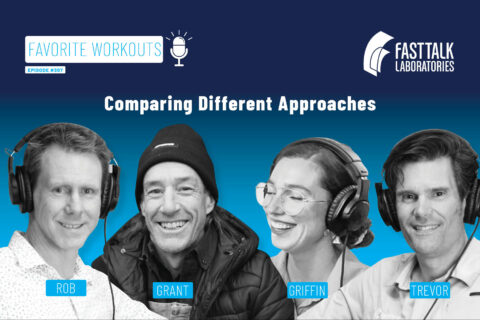Listen in as VeloNews columnist Trevor Connor and editor Caley Fretz discuss a range of topics, including training, physiology, technology, and more.
Have limited time to train? Trevor Connor and Caley Fretz discuss the best way to get the most out of your ride time, and whether it’s possible to substitute long, slow base miles with high intensity training.
Episode Transcript
Caley Fretz 00:00
Welcome to Fast Talk, a VeloNews podcast and everything you need to know to ride like a pro.
Trevor Connor 00:12
Welcome to Fast Talk, the VeloNews podcast. With you today, as always, are your hosts Caley Fretz, senior editor at VeloNews, and myself, Trevor Connor. Coaching and science contributor to the magazine. Today we’re taking on the topic that all our readers and listeners asked about: how to train if you only have 6 to 10 hours per week. This is such an important topic that we’re actually going to divide it across two podcasts. Today we’ll talk about the big picture, the science of why you need to balance intensity and easy riding even if time is limited. And then we’ll offer some thoughts and how to periodize your training. To help us out we’ll talk to one of the big names in training science, Dr. John Hawley, and team Cannondale Drapac rider Andrew Talansky. Let’s make you fast.
Caley Fretz 00:57
I am Caley Fretz. I’m the senior editor here at VeloNews. And how do I get fast with a real job, and 6 to 10 hours a week to train?
Getting Fast With Minimal Time
Trevor Connor 01:08
So that really is the big question that we all want to ask. We know that top pros put in huge, huge volume. That’d be fantastic if we could do it, but most of us have a family, we have jobs. And we’re lucky to even get 10 hours in a week. The reality is, as you pointed out, a lot of people it’s just 6. And so there’s this unspoken belief that if you have 6 hours you go and absolutely tear yourself apart for all 6, and somehow that’s going to compensate for the lack of volume. The short answer is to a degree, yeah, that’s true.
Caley Fretz 01:42
So that does that mean that I should take my 6 hours, and go out and pound my head in the wall, and go as hard as I possibly can? And I think when you go from having a lot of time to having much less time, the natural reaction is to just up the intensity. So that every single time you get back to your desk, you’re just completely shattered. And it feels like that’s the only way to possibly get any gains. Because if I just go out and spin for an hour, what does that do for me?
Intensity vs Volume Training
Trevor Connor 02:12
And that’s the question that people asked. And there’s a lot of people out there really want to say “I can compensate for all that volume with some intensity.” And there’s even people in the research world that are saying this. There’s certainly studies have come out that show, go out and do a bunch of sprint training and you’re going to increase your endurance. And that was a surprise. That was five, six years ago, that research came out. Every physiologist is saying “Well, I never expected that.” But you still have to be careful with the science. And so what we’ll do over the course of this podcast is explain some of that science. That actually is going to go a bit of both ways, and then get to what I think you should be doing. Which is ultimately a balance. And I’ll give you a great example that I was left telling people about of why you need to even be careful about the science. I remember reading a study, bunch of years ago, and I tried to find it. And I can’t quite remember the name of the study. But it was something along the lines of high intensity interval work is far more effective than long, slow volume. They said in the conclusions. “Yeah, you need to be doing interval work long. So volume doesn’t do anything for you.” A lot of people quoted that to say you never need to ride more than an hour. But nobody went into the methodology. And when you actually read how they conducted the study, they had one group do 22 minutes of intervals. But then they had the other group do what they were calling long-slow volume. But they were trying to match them for the amount of work. They did the same number of calories, essentially, that they burned. So the long-slow volume group was training at a very slow pace for 40 minutes. So a better title would have been interval work is more effective than recovery rides for building form. Which isn’t really telling us anything. So you always have to be careful. We used to believe that the long-slow volume really trained some systems. It trained your more central systems, where the high intensity work trained different systems. It trained your periphery. And that actually has been overturned. We’re starting to see something different. And what we’re seeing is no, they actually kind of train the same thing. Which is why I’m saying “Yeah, to a big degree you can compensate for volume.” And I hope you’re ready Caley, because this is where I’m going to geek out a little, if you don’t mind, with the science.
Caley Fretz 04:37
That’s totally acceptable.
Science Behind Endurance Adaptations
Trevor Connor 04:38
To our listeners, our warning right now about the upcoming science. And please feel free to cover your kids ears or fast forward through this moment. There is a master regulator in our body for a lot of what we call our endurance adaptations. Which are an increase in your type one fibers. An increase in mitochondrial biogenesis, which is our oxygen engines. An increase in our ability to use fat for fuel. And there’s there’s several other adaptations. The master regulator is something called peroxisome proliferator activated receptor gamma coactivator one alpha. Or PGC1 One Alpha for short. What they’ve discovered is that both high intensity work and long-slow volume activate PGC One Alpha. So they essentially, once you go down these chains, they produce the same effect. That’s not what we used to think. When we saw this, we went,” Okay, great. Then do the high intensity work. Because you’re ultimately going to end up with the same adaptations. And it’s going to be more time.”
Caley Fretz 05:48
Right. I mean, that makes it sound like I can just go out and and ride as hard as I possibly can for an hour. A couple times a week and end up almost where I was before. But I know from personal experience that my threshold power hasn’t come within 30 watts of where it used to be when I was training relatively full time. And I’ve tried that. I’ve definitely gone out and done the every single day for weeks, just pound my head in the ground. Does not seem to have the same effect.
Trevor Connor 06:15
Right, there’s a little more to the story. And this is why we’ll say that you can only compensate to a degree. Even though the end result is the same, they activate PGC One Alpha through different pathways. High intensity interval work, they do it through the a MPK pathway. And I won’t give you that big word. But it’s basically a drop in the energy within your cells. Where the big volume training actually does it through what’s called the calcium mod – just call it the calcium pathway. I don’t pronounce so good.
Caley Fretz 06:55
It’s the Canadian in you, we don’t blame you.
Trevor Connor 06:57
Thank you. So basically you see a change in the calcium state within the muscle cells. And it takes a long time to produce that. So it’s two different pathways to activate PGC One Alpha. And there’s two factors in that. One is there’s a limit with the high intensity work on how much it activates the PGC One Alpha. More importantly, what they show is you get a bigger effect. A bigger stimulus by activating two pathways. By activating both pathways to PGC One Alpha. So if you only do high intensity interval work, yeah, you’re going to activate those adaptations, but only to a degree. If you only do long-slow volume, same thing. You’re going to activate it but only to a degree. So when you combine the two then you get a bigger effect. And you see the biggest adaptation. So that’s why it’s to a degree. The best training is still a balance of the two.
Caley Fretz 08:00
Beyond the acronym SOUP that you have provided us, there are other adaptations that are going to happen over long rides as well. I would have to think, right? Just simple things. Like the first time each year that I go out for a five hour ride, lots of other things start to hurt. My shoulders, maybe start to hurt. Or my neck get slower, tired. Or you end up with these little aches and pains the first time you go out for that long that you wouldn’t notice over the course of an hour and a half ride. So there’s more there’s more to it than just energy pathways and acronym SOUP. Correct?
Autonomic Stress and Burnout
Trevor Connor 08:36
Correct. If there’s anything you got out of this podcast, I hope it’s a bunch of really big words that you can take to your next group ride. Go up to somebody, throw those words at them, then proclaim you know nothing about cycling and just ride away. So where we need to get to, and thank you for taking me there, because I’ll talk this physiology all day, is what does this mean for your training? There is actually one last little component that’s really important. And what they have shown is that when you train above a certain intensity, when you do these high intensity intervals, you get what’s called autonomic stress. It’s autonomic stress that leads to burnout. That leads to overtraining. Short version of what I’m saying is you can do tons and tons and tons of slow volume. It’s not gonna make you particularly fast, but you’re never really going to burn out on it. But if you do lots and lots of high intensity work, it actually pushed you to burn out really quick. A physiologist over in Europe, who’s very well respected in the cycling community right now, did a great review on this. What he showed in the research time and time again, is you see great gains from two high intensity sessions per week. You don’t really see greater gains by doing three. But as soon as they start doing three or even four high intensity sessions in a week, you very quickly start moving towards burnout. If you start doing four or five year only, it’ll last a couple weeks before you are burnt out and have to be on the bike. And that’s true of amateurs doing six hours a week. And it’s true of pros doing 25-30 hours a week.
Trevor Connor 10:13
And four or five sounds like a lot until you realize that if you race twice over the weekend, that’s only two interval sessions a week. What, two races and a Tuesday-Thursday interval session and you are well on your way to full on burnout.
Trevor Connor 10:24
Right. So if you’re racing on the weekend – I actually have an athlete that I’m working with right now, where we just had this talk this morning, because he was starting to push burnout. And I was telling him, “You have to limit the amount of high intensity work you’re doing.” And so we spoke, he went, “I’m only doing two interval sessions a week.” And I went “Right, but you’re racing twice on the weekend. You’re actually doing four.” So he needed to limit. Really all he could handle was at most one interval session during the week. And then the races. He only trained eight hours a week, seven, eight hours a week. So even that low a weekly volume. If you start adding in too much intensity in there, it’s going to take you bad places.
Trevor Connor 11:03
If you’re surprised to hear that only two intensity sessions per week is ideal, even unlimited time, don’t just take our word for it. We caught up with Dr. John Hawley, head of the exercise and nutrition research group at Australian Catholic University. He’s published over 200 studies and reviews that really define the science of endurance sports. Here’s what he had to say about intensity work.
Dr. John Hawley 11:26
If you’re looking at that intensity, I certainly wouldn’t do two sessions of intensity a day. And I probably only do two, maximum of three a week anyway. With cyclists, probably two. When we’ve done our training interventions of eight times five minutes sets with a cyclist. Which again, it’s in the literature, you can read that. We’ve only done three a week. And that’s that’s been tops. But any more and I think you’d probably go over the top. I really do think two to three sessions, at the top level is all you can handle of those really intense stuff. And when I say intense, I mean glycogen stripping, high carbohydrate, high absolute power outputs or speeds and the actual work time probably 30 to 40 minutes maximum.
Trevor Connor 12:09
As Dr. Hawley pointed out top level cyclists and coaches learn pretty quickly that the amount of high level activity we can do each week is limited. So instead, the science is now focusing on how to best balance the work we do. One area in particular that’s getting a lot of attention is periodization. Or how to map out your weeks and months.
Periodization Training and Team Sky
Caley Fretz 12:28
You mentioned Europe, which remind me of something, specifically Team Sky. There’s been a lot of discussion of Team Sky’s training as of late. Tim Kerrison, whose is their head coach guy, recently teased us all by saying that they’re doing something new. And that everyone else will be doing it soon, and they’re seeing big gains from it. But one of the biggest things that Sky has touted is what they call reverse periodization. You wrote a story, not necessarily about reverse periodization, but a similar concept recently for VeloNews. Which involves, rather than a traditional big long base period moving into a build period and and then into a peak period. You kind of combine the sort of workouts that will be found in each one of those things. Into either a given week or a given month, and you do them all quite regularly. It seems to me that given my six to 10 hours, that sort of concept would be particularly suited to my time constraints. Is that a good idea? Should I be trying to emulate the Team Sky model here?
Trevor Connor 13:34
Should you be doing some sort of reverse periodization model? And I will tell you I am fascinated by reverse periodization. I have hunted down research on it. Anything I can find on it. I’ve talked to people very high up in the cycling world, physiologists and coaches about it. I have found absolutely nothing
Caley Fretz 13:53
Interesting.
Trevor Connor 13:55
Not a study, not anything. And every single person I’ve talked to says “Yeah, we apply a reverse periodization model.” Okay, what is reverse periodization? And everybody has given me a different answer. So I think it’s a really big term that I’m not sure anybody fully knows what it means. But I think when you’re out on the group the concept is to completely flip things. Do ton of high intensity and the base. Which is really appealing because it’s snowing outside, it’s cold, you have less daylight.
Caley Fretz 14:28
Yeah. And that’s what I love about that concept. In January when I maybe ride, five, six hours a week –
Trevor Connor 14:34
Right. And then you add the volume later on.
Caley Fretz 14:37
Right.
Trevor Connor 14:38
I get to go out on a limb here, and I would love to talk to the Team Sky coach. I’ve talked to other pro tour coaches who have certainly agreed with me on this. I will bet a lot of money – that’s not what Team Sky does. What I think has changed is the old model, the old school was nothing but riding slow in the winter. And then you add intensity much, much later on. I think that’s been thrown out. And what you’re seeing is high level athletes are adding intensity, short sprint work, short high intensity interval work. Even very early on in the base season. And that is showing to have gains. And I do think there’s a value to that.
Caley Fretz 15:17
So we did a big piece, a big feature on Ian Boswell. Who rides for Sky. American kid from Oregon. Right before I called him, literally the day before I called him, and I think it was February, he had just gotten back from a two week training camp with Chris Froome. And I went and looked at his Strava. And that was not high intensity interval training. They were riding like 115 miles a day, just the two of them. Which would suggest to me that no way in hell is Chris Froome doing intervals all winter and then doing base miles all spring. Which is again, sort of that reverse periodization that we’ve been fed a little bit. The actual anecdotal evidence, looking at things like Strava, knowing what those camps look like, would suggest that you’re right. That they are maybe peppering in some high intensity work. But it’s still mostly this low intensity, high volume.
Trevor Connor 16:09
Which is further evidence that whatever money I was betting on Team Sky isn’t doing only the intensity in the winter, I should have bet more. So I have to backtrack a little bit and say there hasn’t been no research on reverse periodization. Matter of fact, Dr. Steven Siler and his group over in Europe published a study just this summer, comparing reverse periodization to classic periodization. So they took top level cyclists during their base season. They divided one group into what they called the classic periodization. And that group spent four weeks doing four by 16 minute intervals as hard as they could go. Then they did four weeks of four by eight minute intervals as hard as they could go. So those are a little bit harder. And then finally, four weeks of four by four minute intervals, which were the hardest. The reverse periodized group did the exact same intervals just in the reverse order. So they started with the four by four minutes and built up to the four by 16 minutes. The really interesting, surprising result of the study was that there was really no difference between the two groups. They saw virtually the same improvements. Where there was a difference was they had a third group, which was the mixed group. They did the same three types of intervals, but they mixed it up every week. That group didn’t see the same levels of improvement. So really, the message of the study was that in terms of periodization, it doesn’t seem to matter that much. As long as you are consistent.
Caley Fretz 17:42
Relating to that last conversation, I caught up with Cannondale’s Andrew Talansky on the morning of the time trial at the Amgen Tour California. I asked him first thoughts on periodization, Sky’s training and his own winter preparation.
Caley Fretz 17:53
There’s been this trend toward, what Sky calls it. Reverse periodization or block periodization. Are you still a traditional base miles in the winter, and then build and ramp up kind of guy? Are you throwing intervals in January, in February?
Andrew Talansky 18:09
No, I mean, I think I would be more towards having intervals in there and keeping intensity going. Not just purely easy for months on end. Because I mean, I think you see the way racing is now. You got a Pyrenees, people are at maximum capacity, right? By Pyrenees, Catalunya, Pays Bass, Romandy. I think the days of being able to ease into the season are long gone. I mean, people show up at Tour Down Under a hundred percent ready to race. So I think there’s certain guys who can ease into the season and they make it work. But personally, it’s really not fun racing at this level, when you’re not at where you should be. It’s just suffering. So I’d much prefer to throw some intervals in there and show up the races ready.
Caley Fretz 18:53
Did the style change over the last couple years?
Andrew Talansky 18:56
I don’t think so. I think everybody’s focused so much on it, maybe just because of Sky, right? Because everybody sees how they’re winning. They’re all scientific. The concepts that they’re talking about have been around endurance sports for ages. Around running, swimming, triatholon, and made their way into cycling. With targeting certain races and training for those events and the demands of those events. And for sure, I mean, it’s natural that there’s progress in the last 15-20 yearss. Training as a sport changed to a much more clean one. And the focus became on how can you change your training or diet or nutrition to maximize your physiology. So, I think it’s just natural that that kind of progresses. I don’t think it’s anything revolutionary. I think cycling was just a little behind other endurance sports in that respect.
Trevor Connor 19:46
I’m a bit of a fan here. Steven Siler, Dr. Steven Siler, who’s been doing a lot of research on this – how are pros balancing their training. He’s come up with this model that’s called the polarized model of training. What he did was he took endurance athletes at varying levels. All the way up to the highest level, and looked at how they were balancing out their week. How they were balancing the high intensity work versus the low intensity work. And he broke it into three zones. We typically think of five training zones, he had three. One was that really low intensity, what we think of just long slow base mile rides. Then he had this threshold or above really high intensity zone, which is zone three. And zone two is that in between, and it’s what some people call sweet spot training. What he found was again, and again and again, in all endurance sports, your highest level was doing around 75 to 80% in that zone one. Around 15% of their time in that zone three and virtually no time in between. What was even more interesting was he compared the highest level world champions, Olympic champions, to the next level down. National level riders. And there was no difference in the amount of training the number of hours they were doing per week. The biggest difference he saw was the highest level riders were spending more time at low intensities. It was the the next tier down that was actually doing more high intensity work.
Caley Fretz 21:25
So the top pros are top pros because they really like coffee rides? Is that what you’re telling me?
Trevor Connor 21:31
Basically. Dr. Nugo, saw Milan here in town. He used to work with Ryder Hesjedal when he was working with Hesjedal, this is back when Hesjedal won the Giro. He had Ryder doing virtually no interval work. It was all long, slow volume. The other important thing about the this balance that Dr. Siler talked about is the fact that it was pretty consistent throughout the year. They were mixing the high intensity about 15% with mostly long slow volume in the winter. And during the season. They did maybe a little more high intensity in the season, and a little more of that in between work during the season. But that was it.
Caley Fretz 22:13
So we’ve kind of established that’s the ideal, right? If you’re looking at top athletes, that’s the ideal. But those guys still have time for that long, slow, zone one out of three rise. Bringing it back to myself and listeners out there that are in similar situations, I don’t have time for that. At least it would seem that I don’t. How do we apply that concept, this balance concept to the time constraints of your average working stiff?
Trevor Connor 22:50
Why that is? So that was one of the biggest criticisms of the polarized model. That’s great if you can train 25 hours a week. But what about the rest of us, right? Siler took that criticism and did a study where they took recreational runners who are running about four to six hours a week and had one group train using a polarized model. Exactly the balance I was just telling you. And then they had another group do what you see more typically, which was about 40%. And that zone one, I think they did about 30% in the in between and another 30% of high intensity. So a completely different distribution. But more along that lines of, “You’ve only got six hours. Go and do a lot of hard training.” And even in that study with recreational runners training very low volume, the polarized group saw greater improvements.
Caley Fretz 23:43
That is it for today. We hope you learned a little bit. I certainly did. Thanks again for listening to Fast Talk, the VeloNews performance podcast, and keep an eye out for our next episode.









